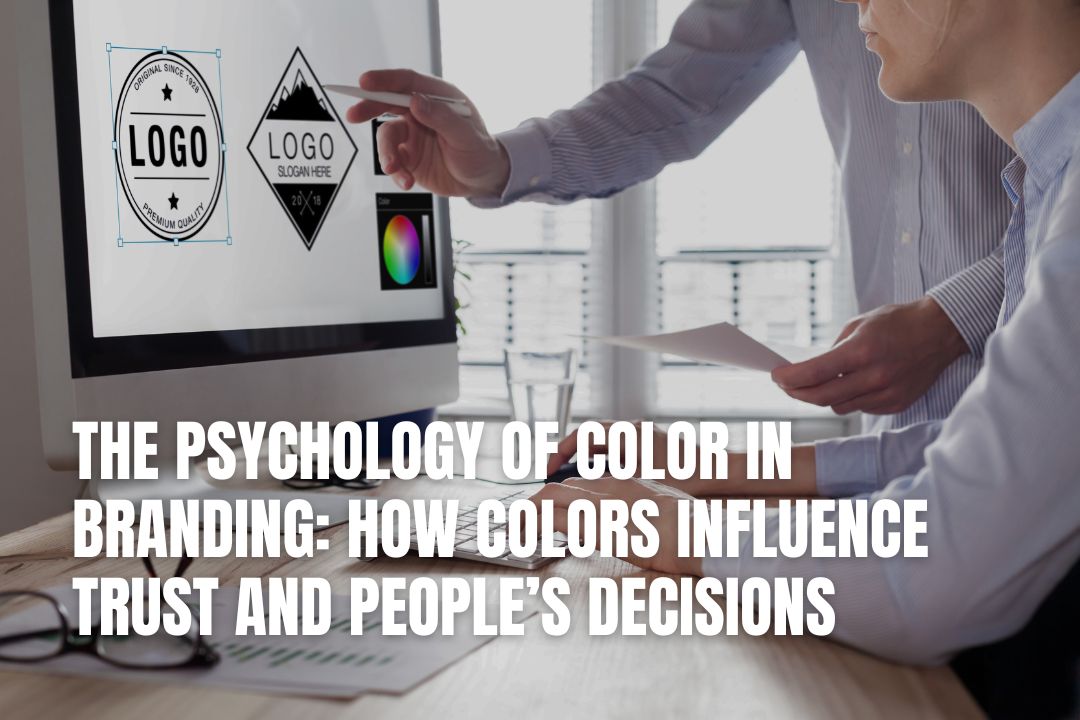The Psychology of Color in Branding: How Colors Influence Trust and People’s Decisions
October 22, 2025

Color is one of the most powerful tools in branding. The shade of your logo, the tone of your packaging, and even the hues in your website layout all work together to tell a story. In fact, research suggests that up to 90% of snap judgments about products can be based on color alone. That’s why brands across industries spend so much time choosing palettes that express who they are, what they value, and how they want customers to feel.
If you want your brand to speak before words do, understanding the psychology of color is the first step.
Key Takeaways on The Psychology of Color in Branding
- Color's Immediate Impact: Colors trigger emotions and perceptions faster than words or images, influencing up to 90% of snap judgments about products.
- Strategic Color Use: Brands choose colors based on psychology, marketing data, and cultural context to define identity and emotion, like red for energy or blue for trust.
- The Science of Emotional Response: Warm colours like red and orange grab attention, while cool tones such as blue and green promote calmness, linking to natural experiences and even aiding patient comfort in healthcare.
- Emotional Connection: Color is crucial for emotional branding, helping you tap into consumer desires. Contrasting colours can guide attention and encourage specific actions.
- Context is Key: A colour's impact depends heavily on its context. Successful brands integrate colour into a complete identity system, ensuring it aligns with typography, imagery, and values.
- Applying Color Effectively: To use colour well, align your choices with your brand's personality and the emotions you want to evoke in your audience, whether it's confidence, creativity, or calm.
Register Your LLC
Company Registration
START NOWWhy Color Matters More Than You Think
Colors trigger emotions faster than text or images. They shape our perceptions, influence purchasing behavior, and even change how we experience taste or temperature. For example, red often communicates energy, passion, and excitement, which is why you’ll see it in fast-food chains and sports branding. Blue, on the other hand, builds feelings of trust, calm, and professionalism, making it a favorite among financial and tech companies.
But it’s not just about choosing a pretty shade. It’s about creating a psychological connection. A well-chosen color palette can make a brand instantly recognizable, think of Coca-Cola’s red, Starbucks’ green, or Tiffany’s iconic blue box. These colors don’t just decorate; they define identity and emotion.
How Brands Use Color Strategically
In branding, color choice goes far beyond aesthetics. It’s a strategic decision grounded in psychology, marketing data, and even cultural context. A color that means “success” in one culture might represent “mourning” in another, which is why global brands adjust their hues for different markets.
Here are a few color associations that brands frequently leverage:
- Red – energy, urgency, excitement, appetite stimulation.
- Orange – friendliness, enthusiasm, creativity.
- Yellow – optimism, clarity, warmth.
- Green – health, nature, growth, tranquility.
- Blue – trust, security, intelligence.
- Purple – luxury, spirituality, imagination.
- Black & White – sophistication, simplicity, timelessness.
A great example is Mastercard’s red and yellow , energetic and confident, ideal for a brand that wants to express accessibility and momentum. Meanwhile, LinkedIn’s cool blue communicates reliability and professionalism.
The Science Behind Color
Each color creates a different emotional response. Warm shades like red, orange, and yellow feel lively and attention-grabbing, while cooler tones such as blue and green promote calmness and trust. Our brains naturally link these colors to familiar experiences, blue skies, green nature, or glowing sunsets. Beyond branding, color also plays a significant role in healthcare. Soft greens can help patients feel calmer and more positive. When people feel comfortable in their surroundings, their anxiety decreases, and their overall experience improves.
This principle even applies to advanced medical fields. Research shows that color can ease anxiety before thoracic spine surgery. Gentle tones like pale green, soft blue, or muted orange help patients feel safer and more relaxed before treatment. These shades create a soothing atmosphere that reduces stress.
Emotional Branding Through Color
Consumers don’t just buy products; they buy feelings. Emotional branding is all about tapping into those underlying human desires, to belong, to feel safe, to be inspired. Color plays a direct role in this. A bright, warm tone can encourage action and excitement, while a muted, pastel shade invites reflection and calm.
Brands often use color contrast strategically to create hierarchy and guide attention. For instance, a call-to-action button in a bold contrasting hue naturally stands out from the rest of the design, leading to higher engagement rates. Color psychology here becomes a silent salesperson, subtle but highly effective.
When Color and Context Work Together
The power of color isn’t absolute, it depends on context. The same shade can evoke completely different emotions depending on where and how it’s used. A deep navy in a law firm’s logo feels authoritative; the same color in a children’s brand feels out of place.
That’s why the most successful brands treat color as part of a complete identity system, one that includes typography, imagery, tone of voice, and values. When all these elements align, color reinforces the story you want people to believe about your brand.
How to Use It in Branding
Understanding color psychology is one thing, but applying it effectively is another. The key is to align your color choices with your brand’s personality and your audience’s emotions. For example, if your brand focuses on innovation and trust, shades of blue can communicate reliability and intelligence. If you want to appear energetic and approachable, warmer tones such as orange or coral can bring that feeling to life.
Before choosing a palette, think about the emotions you want people to associate with your brand. Are you trying to inspire confidence, creativity, luxury, or calm? Each color tells a different story, and small variations in tone or brightness can completely change perception.
The Takeaway: Color Is the Silent Communicator
Whether you’re designing a logo, decorating a clinic, or refreshing your website, remember that color is never just decoration. It’s communication, the kind that speaks to the subconscious and influences how people think, feel, and decide.
The psychology of color in branding is both an art and a science. When used thoughtfully, it can create emotional depth, build trust, and transform ordinary experiences into memorable ones. From the calm greens of a healthcare center to the bold reds of a global brand, color tells a story, one that shapes the decisions we make every day, often without realizing it.
FAQs for The Psychology of Color in Branding: How Colors Influence Trust and People’s Decisions
Why is color so important in branding?
Color is incredibly important because it triggers emotions and perceptions much faster than text or images. It can influence up to 90% of a person's initial judgment about a product or brand, shaping how they feel and even their purchasing decisions.
How do different colors influence trust and decisions?
Different colors evoke specific psychological responses. For example, blue often builds feelings of trust and professionalism, making it popular for financial services. Red can communicate energy and urgency, while green suggests health and nature. Your choice of color directly impacts the emotional connection you build with your audience.
Can cultural differences affect how colors are perceived in branding?
Absolutely, cultural context is vital. A color that signifies success in one culture might represent mourning in another. Global brands often adjust their color palettes for different markets to ensure their message is received as intended and to avoid misunderstandings.
How can I choose the right colors for my brand?
To choose the right colors, you should first consider your brand's personality and the emotions you want to evoke. Think about whether you aim to inspire confidence, creativity, luxury, or calm. Align your color choices with these desired feelings, remembering that even small variations in tone can alter perception. Storific can help you consider these elements when setting up your business.
Is color just about aesthetics in branding?
No, color goes far beyond just looking good. It's a strategic decision grounded in psychology and marketing data. It defines identity, communicates values, and influences consumer behaviour, acting as a silent communicator that speaks to the subconscious.

